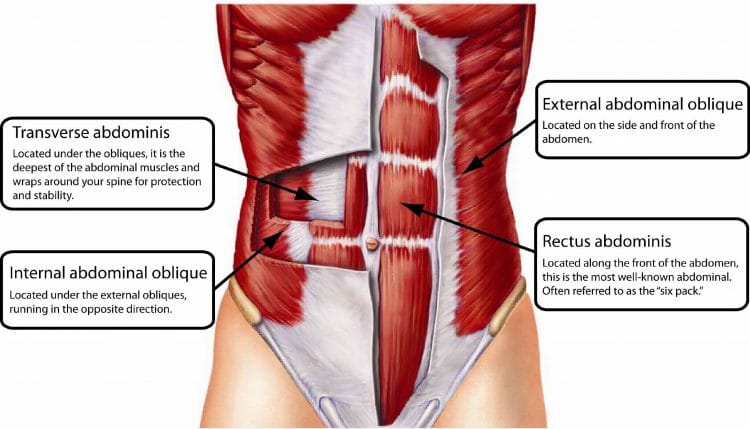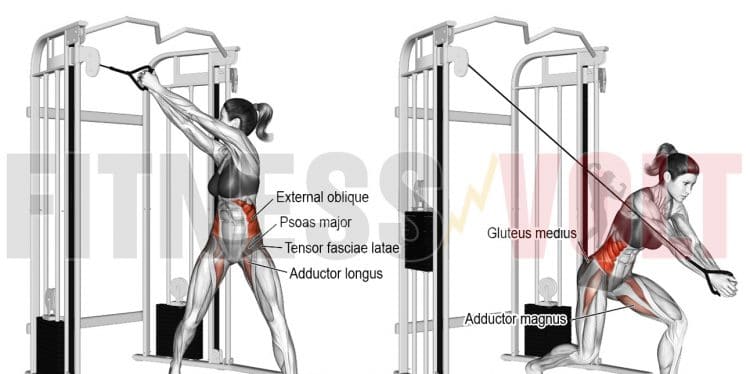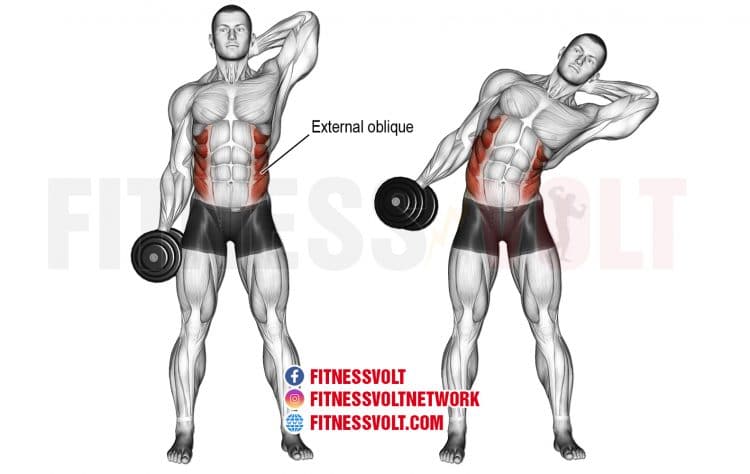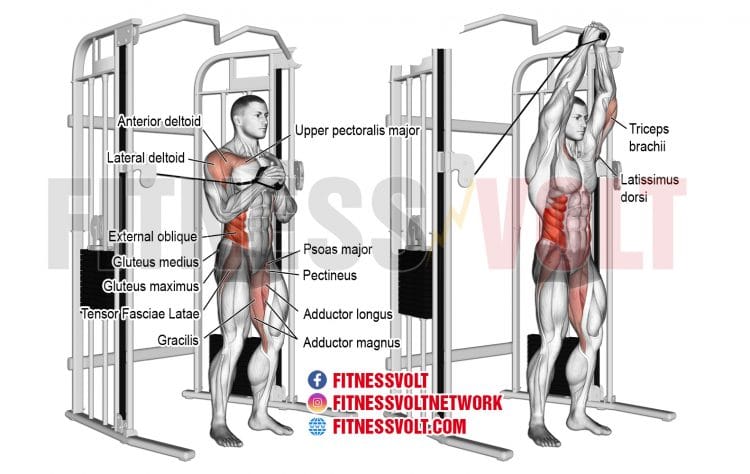Best Weighted Abs Exercises and Workouts – Fitness Volt
You need a great set of abs if you want to look your best naked. That’s why so many people include exercises like crunches, planks, and sit-ups in their workouts, do cardio and watch what they eat.
A shredded six-pack is a fitness, figure, and physique must-have!
However, when it comes to abs training, a lot of lifters train their abs very differently from how they work the rest of their body. For example, instead of doing 2-4 sets of 6-15 reps with a challenging load, they do hundreds of reps with low resistance and work their abs every day.
This makes no sense!
The abs are just another muscle group. You wouldn’t bench press 45lbs for 100 reps five or seven days a week to build your chest, so why do that with your abs?
If you want your abs to show, you need to a) lose the body fat that’s currently covering and obscuring them and b) make them thicker, so they’re more prominent.
The best way to induce some abdominal wall hypertrophy is to drop the high-rep/low-resistance training and start doing weighted abs exercises.
In this article, we reveal the best weighted abs exercises and provide you with a couple of workouts to try.
Abs Anatomy 101
There is more to effective abs training than repeatedly hammering the front of your abdomen. In fact, there are several muscles that make up your marvelous midsection:

Rectus Abdominus
The Rectus abdominus is the long, flat muscle on the front of your abdomen. It’s separated by lines of ligamentous tissue, which give it the six-pack appearance. However, it’s important to note that this six-pack shape is only visible if body fat levels are low enough. How low depends on gender and genetics, but 10% is typical for men and 15% for women.
The main functions of the rectus abdominus are:
- Spinal flexion – bending your spine forward
- Lateral flexion – bending your spine to the side
- Compression of the abdominal contents – such as when you cough or exhale
Obliques
The obliques are located on the side of your abdomen. There are external and internal oblique muscles, but because they work together, most people refer to them as one muscle, simply called the obliques.
The main functions of the obliques are:
- Spinal rotation – twisting your spine
- Lateral flexion – bending your spine to the side
- Compression of the abdominal contents – such as when you cough or exhale
Transverse Abdominus
Where the rectus abdominus runs vertically up the front of your abdomen, the transverse abdominus runs horizontally across it. Acting a lot like a weight training belt, your transverse abdominus encircles your abdominal contents. When it contracts, the TVA increases intra-abdominal pressure to support and stabilize your spine.
While you can’t see the transverse abdominus, no matter how lean you get, it is still a critical muscle. It is involved in every abs exercise, especially those that feature bracing your midsection, i.e., planks.
The main functions of the transverse abdominus are:
- Compression of the abdominal contents – such as when you cough or exhale
- Stabilizing the lumbar spine and pelvis before movement of the lower and upper limbs can occur
Best Weighted Abs Exercises
Build stronger, thicker abs for a more prominent six-pack with these weighted abdominal exercises!
1. Weighted Hanging Knee Raise
Target muscle: Rectus abdominus.
Hanging knee raises are already a great abs exercise, but they’re even better with weight. Save yourself from doing high-rep sets by clamping a dumbbell between your feet or wearing ankle weights. Do this exercise by hanging from a pull-up bar or using a captain’s chair-type apparatus.
How to do it:
- Hang with your legs straight, and core braced.
- Flex your hips, bend your knees, and raise your legs until they are slightly above parallel to the floor. Do not swing your legs up. Instead, move slowly to minimize momentum and keep the tension on your abs.
- Tip the bottom of your pelvis forward, shortening the distance between your hips and sternum, to fully engage your abs.
- Lower your legs and repeat.
- Make this exercise a lot harder by extending your legs and keeping them straight.
2. Weighted Plank
Target muscles: Rectus abdominis, transverse abdominis.
Planks are the perfect example of a good exercise gone bad. They’re great for working your anterior core but doing planks for minutes at a time is inefficient and ineffective. You’ll get a lot more from this exercise if you do it with some additional load.
How to do it:
- Kneel down and place your forearms on the floor, hands together and extended in front of you.
- Walk your feet out and back, so your legs and body are straight. Brace your core.
- Ask a training partner to gently place the required amount of weight on your lower back.
- Without dropping your hips, maintain this position for 20-30 seconds. If you can hold for longer, you need to use more weight.
- Get your partner to remove the weight at the end of your set.
3. Weighted Stability Ball Crunch
Target muscle: Rectus abdominus.
Crunches are a popular abs exercise but can also be ineffective if you are strong enough to do 20-30 or more reps without too much effort. Adding weight and increasing the range of motion with a stability ball makes this classic abs exercise much more effective.
How to do it:
- Sit on a stability ball and hold a weight plate in your hands.
- Walk your feet forward and lean back until the ball fills the natural curve of your lumbar spine. Position the weight plate on your chest.
- Depending on how much weight you are using, you may also need to brace your feet against an immovable object, such as the bottom of a wall.
- Flex your spine and curl your shoulders toward your hips. Tense your abs as hard as possible at the top of each rep.
- Lean back, stretch your abs and repeat.
- Make this exercise more challenging by holding the weight behind your head.
4. Cable Crunch
Target muscle: Rectus abdominus.
The great thing about cable crunches is how easy they make loading your abs. Just move the pin on the weight stack up or down as needed.
This makes cable crunches ideal for muscle-building drop sets. Do a heavy set, lower the weight by 10-15 percent, and then rep out again. This technique allows you to train past your usual failure point.
How to do it:
- Attach a rope handle to a high cable machine. Hold one end in each hand and then kneel down. Pull the handles down to your shoulders, and then keep them there for the duration of your set.
- Bending your spine rather than your hips, pull your shoulders down toward your pelvis, forming a C-shape with your upper body.
- Return to the starting position, getting a good stretch in your abs, and repeat.
- You can also do this exercise while standing.
5. Weighted Ab Wheel Rollout
Target muscle: Rectus abdominus, transverse abdominis.
Ab wheel rollouts are already a challenging exercise, but they’re even harder if you wear a weighted vest. A little load goes a long way with this exercise so start light and only increase the weight gradually. 5-10% of your body weight is a good starting point for most people.
How to do it:
- Wearing your weighted vest, kneel down and place your ab wheel on the floor in front of you. Brace your core.
- Keeping your arms straight, extend your hips and push the wheel away from you, lowering your chest and abdomen down toward the floor. Take care not to arch your lower back.
- Pull yourself back to the starting position and repeat.
- You can also do this exercise with a barbell – making them even harder.
7. Weighted V-Sit
Target muscle: Rectus abdominus.
The V-sit is so-called because that’s the shape your body makes at the mid-point of each rep. Involving a leg lift and an upper body crunch, this is an effective total abs exercise. However, it’s also pretty challenging, so make sure you can do it unweighted before trying this variation.
How to do it:
- Lie on your back with your legs straight and arms above your head. Hold a weight plate, medicine ball, or single dumbbell in your hands. Brace your abs.
- Keeping your arms and legs straight, raise both ends of your body and reach up toward your feet, so your body forms a V-shape.
- Lie back down flat on the floor and repeat.
8. Single-Arm Farmer’s Walk
Target muscle: Obliques, rectus abdominis, transverse abdominis.
Farmer’s walks are usually thought of as a grip or conditioning exercise. While that’s very much the case, doing this exercise with one arm turns it into an excellent lateral abdominal exercise. You’ll need to use your entire core to keep your torso upright.
How to do it:
- Hold a heavy dumbbell or kettlebell down by your side. Brace your abs, pull your shoulders down and back, and stand perfectly upright.
- Walk around your training area until you cannot keep your torso straight or your forearms start to fail. Alternatively, you can march on the spot if you don’t have space to stroll.
- Put the weight on the floor, swap hands, and repeat.
- You can also do this exercise with your arm raised above your head. This is called a waiter’s walk. The waiter’s walk challenges shoulder stability as well as working your core.
9. Weighted Russian Twist
Target muscle: Obliques, rectus abdominis.
While no one seems to know why this exercise is called Russian twists, there is no denying its effectiveness for training your oblique or waist muscles. However, this is no one-trick-pony; Russian twists are also pretty tough on your rectus abdominis.
How to do it:
- Sit on the floor with your legs bent and feet flat. Sit up, so your body is inclined to about 45 degrees. Hold a small weight plate, dumbbell, or medicine ball in your hands. Extend your arms in front of you.
- Rotate your upper body to the left and then to the right, lowering the weight down toward the floor. Keep your torso at roughly the same angle throughout.
- You can also do this exercise with your feet in the air, which makes balancing more demanding, challenging your core and stabilizer muscles more.
10. Weighted Windshield Wiper
Target muscle: Obliques, rectus abdominis.
Windshield wipers were one of the exercises that special forces strength and conditioning coach Mark Twight used to train the actors for the movie 300. For this move, you must work hard to stabilize a weight while rotating your lower body and working your core. This results in a uniquely challenging exercise that hammers your abs and obliques.
How to do it:
- Lie on the floor and press a barbell or dumbbells up to arms’ length over your chest.
- Brace your abs and raise your legs, so they’re perpendicular to the floor. Press your lower back into the floor.
- Keeping your arms stationary, rotate your hips and lower your legs down toward the floor.
- Return to the center and repeat on the opposite side.
- If you are feeling extra strong, try doing a leg lower and raise each time you return to the center.
11. Cable Woodchop
Target muscle: Obliques, transverse abdominis.
As the name implies, Cable Woodchop exercise replicates chopping wood with an ax or swinging a sledgehammer. This type of rotational movement is an excellent way to train your obliques or waist muscles. It’s typically done using an adjustable cable machine. Still, you can do it almost as effectively with a resistance band fixed to a suitable anchor.

How to do it:
- Attach a D-shaped handle to a high cable pulley machine.
- Stand side-on to the handle and then reach up and grab it. Bend your knees slightly and brace your abs.
- Rotate your upper body through 180 degrees, taking your hands from high to low in a diagonal movement.
- Return to the starting position and repeat.
- You can also do this movement with a more horizontal action by setting the handle to shoulder height or a low-to-high woodchop by putting the handle at about knee height.
12. Weighted Side Bend
Target muscle: Obliques, rectus abdominis.
Weighed side bends are one of those exercises that a lot of people do wrong. To save time and try to work both sides at the same time, ill-informed lifters hold a dumbbell in each hand.
This means the weights cancel each other out and make this exercise ineffective. So, don’t be a dummy – use one dumbbell to ensure your abs get a more intense workout!

How to do it:
- Stand with your feet about shoulder-width apart, knees slightly bent. Hold a dumbbell or kettlebell in one hand.
- Keeping your shoulders and hips square, lean over and lower the weight down the outside of your leg.
- Return to the upright position and, if you wish, lean a little the other way to really fire up your obliques.
- Repeat for the desired number of reps and then swap sides.
13. Pallof Cable Press
Target muscle: Obliques, transverse abdominis, rectus abdominis.
The Pallof press is an anti-rotation exercise. Invented by physical therapist John Pallof, this exercise teaches you to resist unwanted movement. In some ways, it’s like doing a non-rotational plank. This is a useful weighted exercise for athletes and anyone who wants a strong, toned midsection.

How to do it:
- Attach a D-shaped handle to a cable machine and set it to shoulder height. Hold the handle and stand sideways onto the machine. Bring your hands in close to your chest. Stand with your feet shoulder-width apart and brace your abs.
- Extend your arms in front of you as you resist the rotational pull of the machine.
- Bring your arms back in and repeat.
- Rest a moment, switch sides, and do the same number of reps facing the other way.
14. Single-Arm Overhead Press
Target muscle: Obliques, rectus abdominis, transverse abdominis.
All standing overhead pressing exercises involve your core, albeit indirectly. However, unilateral or one-sided exercises like this one-arm press make your midsection muscles work much harder. You’ll need to engage your abs to keep your torso rigid and upright. This exercise is a great twofer as it works your shoulders and abs at the same time.

How to do it:
- Stand with your feet shoulder-width apart, knees slightly bent. Raise and hold a single dumbbell or kettlebell to shoulder height. Brace your core and pull your shoulders down and back.
- Without leaning to the side, press the weight up and overhead to arms’ length.
- Lower the weight back to your shoulder and repeat.
- You can also do this exercise in a half-kneeling position to take your legs out of the movement and make your weight feel heavier.
15. Weighted Saxon Side Bend
Target muscle: Obliques, rectus abdominis.
Arthur Saxon was a late 19th/early 20th-century German strongman. Famed for his incredible lifting prowess, Saxon also invented several exercises, some of which are still performed today. Saxon side bends are a great way to train your core using a medicine ball, dumbbell, kettlebell, or weight plate.
How to do it:
- Stand with your feet shoulder-width apart, knees slightly bent. Raise your medicine ball above your head so your arms are straight.
- Without twisting your shoulders or hips, lean over to the left as far as you can and then return to the center. Next, lean over to the right.
- Continue leaning from left to right for the required number of reps.
Weighted Abs Workouts
While you could just add a couple of these exercises to your usual abs workout, you’ll get better results from a more structured routine. So, here are three short but brutal weighted abs workouts. Do them on non-consecutive, e.g., Monday, Wednesday, and Friday at the end of your regular strength training program or after cardio.
Save time by performing them circuit style, moving from one exercise to the next without resting. Alternatively, do 2-4 sets of 12-20 reps of each exercise, resting 60-90 seconds between sets.
#
Workout one
Workout two
Workout three
1
Weighted rollout
Weighted V-sit
Weighted knee raise
2
Windshield wipers
Pallof press
Cable woodchop
3
Side bend
Farmer’s walk
Single-arm overhead press
Wrapping Up
Bodyweight abs exercises are useful for home exercisers and anyone who travels a lot. Requiring nothing but an exercise mat or folded towel to lie on, you can do bodyweight abs exercises anywhere and anytime, making them the ultimate in excuse-free workouts.
But, you may need more than your body weight to challenge your abs, especially if you are an intermediate or advanced exerciser. And that’s where weighted abs exercises come in.
Using weights means you can train your abs just like any other muscle group, i.e., progressively by adding load and not just doing more reps. This is arguably the most effective way to make your workouts more productive.
So, stop chasing reps with bodyweight exercises and look for ways to increase the weight. Whether you use a weighted vest, dumbbells, a cable machine, or resistance bands, loading up your abs with extra weight will create more muscle tension and make your workouts much more effective. Plus, it will save you from the boredom of doing 100s of reps or planking for five minutes at a time!






